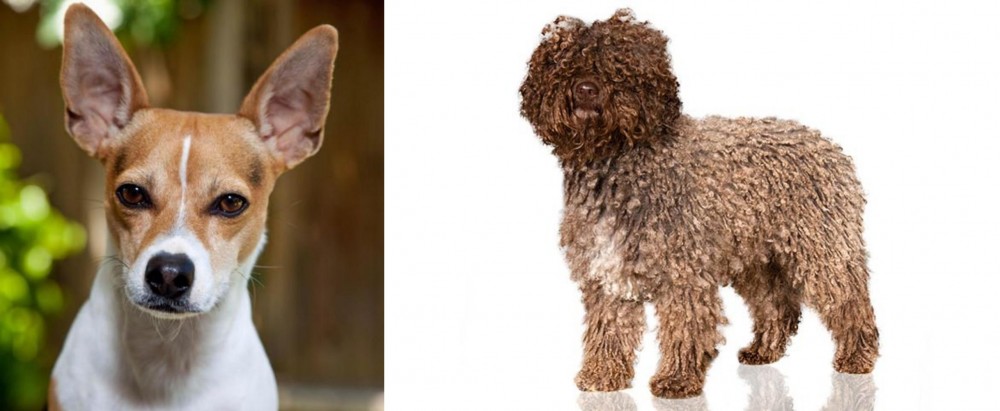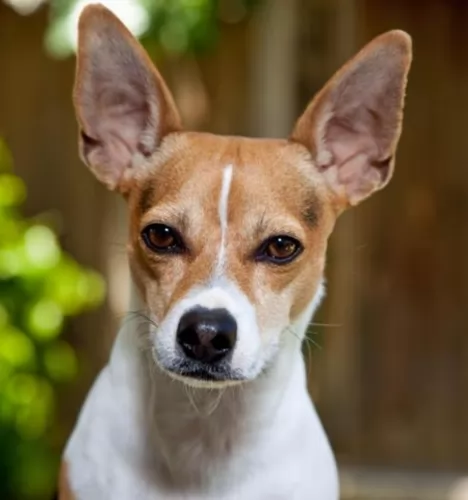 Petzlover
Petzlover Rat Terrier is originated from United States but Spanish Water Dog is originated from Spain. Rat Terrier may grow 14 cm / 5 inches shorter than Spanish Water Dog. Rat Terrier may weigh 18 kg / 39 pounds lesser than Spanish Water Dog. Rat Terrier may live 4 years more than Spanish Water Dog. Both Rat Terrier and Spanish Water Dog has almost same litter size. Rat Terrier requires Low Maintenance. But Spanish Water Dog requires Moderate Maintenance
Rat Terrier is originated from United States but Spanish Water Dog is originated from Spain. Rat Terrier may grow 14 cm / 5 inches shorter than Spanish Water Dog. Rat Terrier may weigh 18 kg / 39 pounds lesser than Spanish Water Dog. Rat Terrier may live 4 years more than Spanish Water Dog. Both Rat Terrier and Spanish Water Dog has almost same litter size. Rat Terrier requires Low Maintenance. But Spanish Water Dog requires Moderate Maintenance
 Known also as the American Rat Terrier or even as the Rattie, this American dog breed is a farm dog, common on family farms during the 1920's and 1930's.
Known also as the American Rat Terrier or even as the Rattie, this American dog breed is a farm dog, common on family farms during the 1920's and 1930's.
Miniatures or Standards, these dogs are also recognized by the American Kennel Clubs and thought of today as a multi-purpose companion dog.
He is an American dog breed, having come about from Fox Terriers, Old English White Terriers, Bull Terriers, Manchester Terriers and others. Whippets and Italian Greyhounds have also come into the mix to add speed as a characteristic.
The Rat Terrier started to decline in numbers, and by the 1950's the numbers of the dog were so low that breeders stepped in to restore numbers.
 Bred in Spain to guard and herd sheep, the Spanish Water Dog was also used in hunting because he could retrieve in water. The breed is closely aligned with other water dogs like the Irish Water Spaniel, Portuguese Water Dog and French Barbel. It is especially true that the Spanish Water Dog and the Portuguese Water Dog share some of the same ancestors. The two breeds are closely related.
Bred in Spain to guard and herd sheep, the Spanish Water Dog was also used in hunting because he could retrieve in water. The breed is closely aligned with other water dogs like the Irish Water Spaniel, Portuguese Water Dog and French Barbel. It is especially true that the Spanish Water Dog and the Portuguese Water Dog share some of the same ancestors. The two breeds are closely related.
In the early days of the breed, they were separated into three different sizes and types. The dogs from Northern Spain were smaller than the others and came from the regions of Cantabria and Asturias. These lighter colored dogs eventually became their own breed – the Cantabria Water Dog. The second group came from western Andalusia marsh lands. He had a long chorded coat. The third group was the strongest and largest and came from the southern Andalusian sierras. This was by far the largest and most influential group, most of whom were herders. Eventually the groups interbred and today’s SWD carries the traits of all three. They were and still are a very versatile breed. In addition to herding they fished or retrieved for hunters.
The breed was revived in the 1970”s by two breeders, Santiago Montesinos and Antonio Garcia Perez travelled through southern Spain to buy or borrow dogs for breeding. By 1980, they had established the Spanish Water Dog Club of Spain and reestablished the breed. They fought to the breed recognized in Spain first. After five years of hard work, the Federation Cynologique Internationale recognized the breed permanently in 1999.
The UKC, or United Kennel Club, of the United States, recognized the breed in 2001, accepting them for confirmation by 2004. In the United States the breed was championed by Ken and Jerry Mann to attain that UKC recognition. Still the AKC, or American Kennel Club, held out on their recognition. The Manns showed the SWD in 2000 in the AKC Rare Breed Conformation and the UKC multi-breed show in 2004.
The Manns also used their breed for herding in the United States in entered them into the herding competition. In the they advocated for and got the SWD into the herding group for confirmation with the UKC in 2013. The American Kennel Club approved the requests of the Spanish Water Dog Club, Inc and recognized the breed in 2005 as foundation stock. By 2008 the AKC recognized the SWD to be able to compete in field trials by not conformation. In 2015 the SWD will be admitting to AKC conformation and fully recognized as a member of the herding group. They were also recognized by the American Herding Breed Association in 2007.
 There are different sized Rat Terriers, but the mid-sized one stands roughly between 20 and 36cm in height and weighs between 3 and 4kg.
There are different sized Rat Terriers, but the mid-sized one stands roughly between 20 and 36cm in height and weighs between 3 and 4kg.
The single coat is short and smooth and comes in colors such as tan, grey, chocolate, black and in solid colors too such as white. They are mostly in tri-colors - white, tan, black. Ticking is also seen.
With his short coat he is seen as a low maintenance dog even though he is still a shedder, with heavier seasonal shedding.
The ears can sometimes be erect, otherwise they are half-erect, half floppy. The tail has always been traditionally docked, giving him a nice, distinctive look, but today the tail is often just left un-docked. It isn't unusual for a puppy to be born with a short or long tail.
Intelligent, wary, loyal, loving, playful but stubborn, your Rat Terrier is a little bit wary around strangers. Training and socialization can be good for this dog and help him t be obedient and well mannered in all situations. These dogs also want to please. He is an active dog too and makes a great playmate for children, getting on well with kids and other pets in the home.
 The Spanish Water Dog is an athletic, medium size, robust breed that is not as tall as it is long. In countries like the US, the tails are docked but it is not a conformation fault if they are not. The carry themselves with pride and elegance, have a strong head and expressive eyes which are brown. They have flat skulls and wide set eyes. Their paw pads, eye-rims and nose should be darker than their coat or at least the same color. Their eyes are chestnut, hazel or dark brown and their ears are medium height and triangular. His coat is curly and his topline is straight. With a broad chest and arched rib, he is a very athletic looking dog. The breed has much respiratory capacity with broad shoulders and straight sturdy legs. The breed has rounded feet , tight toes, and resistant pads.
The Spanish Water Dog is an athletic, medium size, robust breed that is not as tall as it is long. In countries like the US, the tails are docked but it is not a conformation fault if they are not. The carry themselves with pride and elegance, have a strong head and expressive eyes which are brown. They have flat skulls and wide set eyes. Their paw pads, eye-rims and nose should be darker than their coat or at least the same color. Their eyes are chestnut, hazel or dark brown and their ears are medium height and triangular. His coat is curly and his topline is straight. With a broad chest and arched rib, he is a very athletic looking dog. The breed has much respiratory capacity with broad shoulders and straight sturdy legs. The breed has rounded feet , tight toes, and resistant pads.
 The Rat Terrier is such a clever, bright dog. These characteristics make him an excellent watchdog with strong jaws for his role of getting rid of rats on farms.
The Rat Terrier is such a clever, bright dog. These characteristics make him an excellent watchdog with strong jaws for his role of getting rid of rats on farms.
Even though he is a small dog, he isn’t particularly suited to life in the city on a small property as he has quite a shrill bark.
Because of him being small to medium in size, he is well suited to many homes, but you just have to watch out in the city if you live close to your neighbors as he is fairly noisy and active.
He would love a large property where he can just be himself. Provide him with the right home, and you’l have a friend for life.
 Rat Terriers are generally feisty, healthy dogs who, with good care, can live to the ripe old age of 16, 17 or 18 years of age.
Rat Terriers are generally feisty, healthy dogs who, with good care, can live to the ripe old age of 16, 17 or 18 years of age.
Just like with many other dogs, he can develop some of the more common dog illnesses there are. If you're opting for a puppy, find a good, reputable breeder.
It can be tricky trying to decide what kind of allergies are causing such problems with your pet. A skin allergy can cause a lot of itchiness and pain for your canine friend and he will bite and lick on the affected spots and make the situation worse. You will need to get him to the vet for some kind of treatment, as such an ailment can drive him mad.
This is a common problem in dogs, with the kneecap or patella being dislocated. It can cause a lot of pain and can be crippling for your dog.
 The Spanish Water Dog has much of the same health problems as the other water dogs and dogs their size and heritage. Here are some of the health issues they are prone to.
The Spanish Water Dog has much of the same health problems as the other water dogs and dogs their size and heritage. Here are some of the health issues they are prone to.
• Exocrine Pancreatic Insufficiency – inability to digest food – can be treated.
• CHG – Congenital Hypothyroidism with Goiter – inherited and pups don’t grow correctly.
• Neuroaxonal Dystrophy – cognitive and muscular dysfunction. Vitamin E and insulin deficiency
 Your Rat Terrier can easily reach 16, 17 or 18 years of age with good food. While you do get some excellent commercially manufactured dog foods, you want to add variety by including some nutritious home-made food too.
Your Rat Terrier can easily reach 16, 17 or 18 years of age with good food. While you do get some excellent commercially manufactured dog foods, you want to add variety by including some nutritious home-made food too.
Boiled chicken, brown rice or pasta and spinach, sweet potatoes and carrots are a healthy choice for your pet. Chop it up and add it into the dry kibble a couple of times a week.No complications - just plain and simple - the way dogs love it.
Some raw meat added in from time to time will help his skin and coat remain healthy. Never leave him without a constant source of fresh, cool water.
The Rat Terrier is an active dog. He just loves to dig too, so if you live close to a beach, he will love running and digging in the sand. If this isn’t possible, he will be happy to be taken on walks with you and maybe for a run in the park.
He loves all ball games and running after a frisbee, and he’s so clever, maybe you can even teach him to fetch the frisbee for you.
The Rat Terrier is a low-maintenance dog and only requires having his coat brushed twice a week.
Check inside his mouth for bad teeth. You can even brush his teeth with special canine toothpaste and brush to remove tartar buildup.
Keep his nails trimmed too if he doesn’t wear them down naturally so as to prevent them hooking on things and ripping into the flesh.
Check inside your dog’s ears too. If you’re not experienced with trimming dog nails or cleaning inside dog’s ears, your vet or professional groomer will do it for you.
During these grooming sessions with your Rat Terrier, check for fleas and ticks as well as for any sores or new lumps. Also, his eyes should be clear and bright with no discharge or redness.
 1.Feeding the puppy – Because of the breed propensity to some genetic dietary issues it is important to feed high quality food made from mostly meat. Avoid grains as much as possible. Don’t feed adult foods to the puppies. Feed puppy breed specific or medium size dogs.
1.Feeding the puppy – Because of the breed propensity to some genetic dietary issues it is important to feed high quality food made from mostly meat. Avoid grains as much as possible. Don’t feed adult foods to the puppies. Feed puppy breed specific or medium size dogs.
2.Feeding the adult - Feed the adult as little grain and as much protein as possible. Feed adult breed specific or medium size dog’s food.
4. Games and Exercises – This is a working breed. Remember they are both herders and hunters and need exercise. They love strenuous hiking, running, jogging, long walks, swimming and playing fetch. Don’t over work the puppy/young dog until they have matured and their growth plates close.